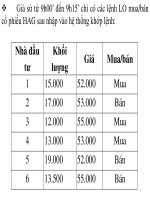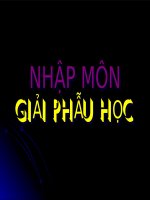Nhập môn Tân đầu châm Yahamoto
Bạn đang xem bản rút gọn của tài liệu. Xem và tải ngay bản đầy đủ của tài liệu tại đây (17.65 MB, 77 trang )
Yamamoto
New Scalp Acupuncture
(YNSA)
Dr. med. Toshikatsu
Yamamoto (Ph. D.)
YNSA Seminar
YNSA
Yamamoto New Scalp Acupuncture
since 1973
Toshikatsu Yamamoto MD.Ph.D.Yamamoto Rehabilitation Clinic Miyasaki-Kaida, 4514-1 , 889-2161 Japan
FAX: (+ 81) 985-65-2637
e-mail:
copyright with Dr. T. Yamamoto, and family
History and Development
●
●
●
The Yamamoto New Scalp Acupuncture (YNSA) was
founded in the sixties by Dr. med Toshikatsu Yamamoto
(Ph.D.).
During the treatment of patients suffering of pain and
paralysis he discovered sensitive/painful points on the
skull showing somatoform assignments of the entire
body.
He systemized this new reflex therapeutic acupuncture
form and refined it further in the last 40 years.
History and Development
History and Development
●
●
In addition to the discovery of a new microsystem of the
skull Yamamoto modified the oriental abdominal
diagnosis system as a diagnostic tool and combined the
abdominal diagnostic areals with the individual
associated scalp acupuncture points.
Moreover, he detected another similar region as the
abdominal diagnosis system in the area of the lateral
neck triangle, which can be easily used for the diagnosis
of indexed YNSA points at the scalp.
basal ganglion
cerebellum
muscle sterno-cleido-mastoid
cerebrum
heart
gallbladder
spleen/pancreas
pericardium
cervical spine
stomach
lung
thoracic spine
liver
umbelicus
triple heater
small intestine
large intestine
heart
pericardium
lung
small intestine,
gallbladder
spleen/pancreas
stomach
liver
triple heater
lumbar spine
large intestine
kidney
kidney
bladder
uterus
prostata
YNSA modified abdominal diagnosis
muscle trapezius
clavicle
oral pi.
kidney
bladder
uterus
prostata
spine/brain
YNSA Neck-Diagnosis
copyright with Dr. T. Yamamoto and family
P4
2 Microsystems
• Basic points
• Sensory organ points
• Brain points
• Ypsilon points
2 Microsystems
●
●
The BASIC-Points shows
the division of the body
anatomically.
The representation zones
are categorized in
– the kinetic system
– the sensory organs
– the central nervous
system.
2 Microsystems
●
●
The YNSA YPSILON-Points
shows the division of the
body functinally.
With these points it is
possible to treat
dysturbances of the
meridian system, from the
inner organs and the
assignments like the
Traditionell Chinese
Medicine.
Indications for YNSA
●
●
YNSA is a fast and efficient treatment of headache,
pain in the musculoskeletal system, functional
disorders of internal organs and paralysis of various
origins and some other neurological disorders.
The success in treating patients with pain is following
almost immediately after correct applied needle.
YIN
YANG
J
B
brain
brain
B
eyes
nose
mouth
A
B
ear
H
C
I
K
Lumbar Pts. Yang
brain
H
A
B
eyes
nose
mouth
C
ear
D
F
G
Lumbar Pts.
Yin
The 2 drawings on this Page show the YNSA Basic Points (red), YNSA Sensory Points ( blue) and
YNSA Brain Point (yellow) in the frontal YIN and occipital YANG position.
Basic A = Neck
B = shoulder
C = shoulder , arm , hand
D = lumbar region
Basic Pt. E = chest
F = ischialgia
G = knee
copyright with Dr. T. Yamamoto, and family
P1
The Location is by the forehead hair
Indications for YNSA Basic-Points
●
●
●
●
●
any dysfunction and pain involving the kinetic system
pathological changes
injury and postoperative pain and dysfunction
paralysis, hemiplegia, pallaesthesia
To a lesser extend, dysfunction of inner organs, eg
Asthma bronchiale, bronchitis, dyspnoe, palpitations,
hyperventilation, angina pectoris.
Indications for YNSA Basic-Points
A-Point:
● Relief of pain after injury or post-operative
● Headache and migraine of any origin
● Cervical syndrome
● Whiplash
● Vertigo
● Trigeminal or any facial, neck or shoulder neuralgia,
toothache before, during or after dental treatment
● Cerebral disturbances
● Facial paralysis
Indications for YNSA Basic-Points
B-Point:
● All reversible conditions within the areas supplied by
cervical nerves
● Pain relief after injury or postoperative
● Neck-shoulder-arm-syndome
● Shoulder pain after arm-fractures, due to immobile
positioning
● Hemiplegia etc.
Indications for YNSA Basic-Points
C-Point:
● Pain after accidents and post operative
● Frozen shoulder
● Dislocation of shoulder joint, for easier manipulation
● Sprained joints, fractures
● Rheumatoid arthritis
● Bursitis, tennis elbow, tendosynovitis
● Hemiplegia, paraplegia
● Parkinson‘s syndrome
● Multiple sclerosis
● Paraesthesia, circulatory disturbances, etc-
Indications for YNSA Basic-Points
D-Point:
● Lumbago, whatever cause including herniated
intervertebral disc
● Circulatry disturbances of the legs
● Raynaud‘s syndrome
● Parkinson‘s syndrome
● Neuralgia rheumatism, arthritis
● Muscle cramps, sciatica
● Hemiplegia, Paraplegia
● Multiple sclerosis
● Fractues and sprains, gout
Indications for YNSA Basic-Points
E-Point:
All reversible conditions posttraumatic and postperative
pain
● Intercostal neuralgia
● Herpes zoster
● Fractures
A number of internal diseases cam also be treatde, such as
Angina pectoris, palpitations
● Hyperventilation, dyspnoe
● Bronchitis, persistent cough, asthma
Indications for YNSA Basic-Points
F-Point:
● Sciatica
G-Point:
● Gonalgia
H- and I-Point:
● Chronic lumbalgia
● Chronic pain and numbness of the lower extremities, or
palm of the hands
YNSA Praxis
Point Localisation
BASIC-Points ventral
●
Auge
●
Eye
●
Ojo
●
Nase
●
Nose
●
Nariz
●
Ohr
●
Ear
●
Oreja
●
Mund
●
Mouth
●
Boca
The Location is by the forehead hair. You can find it, if you frowning the skin.
BASIC-Points lateral
●
Auge
●
Eye
●
Ojo
●
Nase
●
Nose
●
Nariz
●
Ohr
●
Ear
●
Oreja
●
Mund
●
Mouth
●
Boca
BASIC-Points occipital
●
Auge
●
Eye
●
Ojo
●
Nase
●
Nose
●
Nariz
●
Ohr
●
Ear
●
Oreja
●
Mund
●
Mouth
●
Boca









